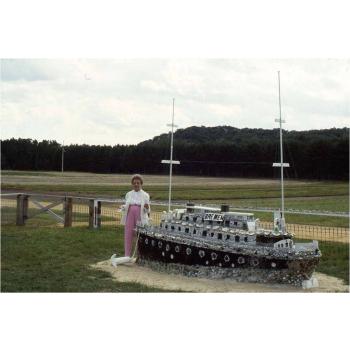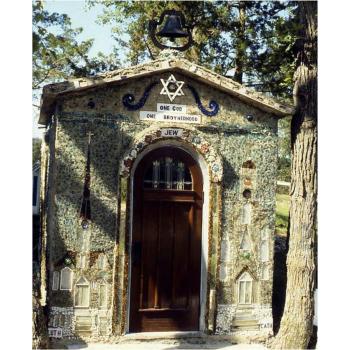Wegner Grotto
Paul and Matilda Wegner emigrated from Germany in 1885 and settled in LaCrosse, Wisconsin, where Paul worked for the railroad. In 1889 the Wegners purchased a farm at Tubbs Corners near the village of Cataract in Monroe County. The couple farmed the land and raised five children.
In 1916, they left the farm’s operation to one of their sons and moved to nearby Bangor, Wisconsin, where Paul owned and operated a Ford garage. After Paul’s retirement in 1927, the couple continued to live in Bangor during the winters, but spent their summers at their Cataract farm.
It was a visit to the wondrous Holy Ghost Park of Father Mathias Wernerus in Dickeyville -- at the very southwestern corner of Wisconsin -- that inspired the Wegners to begin their own “retirement project.” In the summer of 1929 on their farm, they began building fences, and within a year their first sculpture: a twelve-foot concrete facsimile of the celebrated Bremen ocean liner.
The building continued from 1929 until after 1936, primarily during the summer months; however, many pieces, including the walls of the church, were created in Bangor during the winter and then transported to the farm for installation. The extraordinary sculpture environment slowly grew over these years to include a fanciful American flag, a giant reproduction of the Wegners’ 50th anniversary cake, and a glass-encrusted birdhouse.
Other constructions were religious in nature. The magnificent Prayer Garden, Glass Church, and Peace Monument once served as places for quiet reflection, wedding ceremonies, public preaching, family picnics, and community gatherings. Still surrounding the yard is an ornate fence with a concrete archway, which spells out the word “Home” in crushed black glass.
Like so many other environmental builders, Paul and Matilda Wegner never had any formal training in art. Their imaginative sculpture environment arose from a powerful personal vision outside the academic tradition of fine art and beyond the ethnic or community traditions of folk art. Transforming ordinary materials into an ambitious series of patriotic and religious monuments, the Wegners created a remarkable “grotto,” a fantastic garden of concrete sculpture decorated with thousands of glittering glass shards.
The couple engulfed the grotto in color and light by decorating their concrete sculptures with a brilliant mosaic of shattered glass and broken crockery. Hidden within the thousands and thousands of sparkling shards are a number of curiosities – broken beer bottles, iridescent carnival glass, old heirloom china, the remnants from a few porcelain figures, seashells, Indian arrowheads, and gunpowder casings. Combining their fantastic vision with such an imaginative use of unexpected materials, the Wegner’s Grotto stands as a significant work of art.
On March 19, 1937, Paul Wegner died after a long illness. His funeral was held in the Glass Church. Matilda continued to work on the grotto, adding finishing touches to many of the pieces and creating colorful embellishments for the nearby cemetery where Paul was buried. Matilda died November 20, 1942. The couple’s graves are marked by monuments similar to the sculptures found in the Grotto.
The Wegner Grotto, known locally as the Glass Church, was owned by the Wegner family until 1986 when Kohler Foundation purchased the site as part of its commitment to document and preserve significant art environments and folk architecture. Restoration, funded Kohler Foundation, included extensive structural stabilization and surface repair of the sculptures as well as landscape clearing to re-establish the environment. Gifted to Monroe County in September 1987, the Wegner Grotto is a stunning sight to behold amidst the quiet Wisconsin countryside.
Additional information can be found at www.monroecountyhistory.org or by calling Monroe County Local History Room, 608-269-8680. The site is open Memorial Day through Labor Day.
The Wisconsin Art Environment Consortium created the video podcast below about the Wegner Grotto:
Paul and Matilda Wegner Grotto






